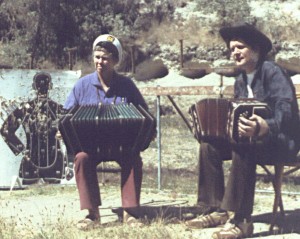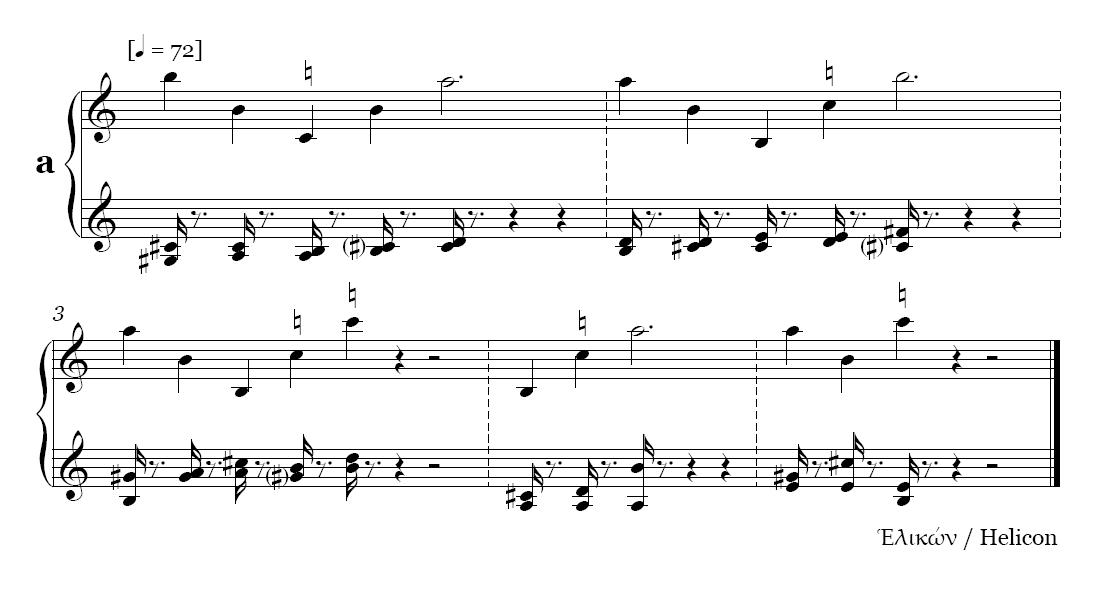Barney Childs on his Eighth String Quartet:
"Okay, I threw away a mention of the Eighth String Quartet and its C Major chord... Nobody wants string quartets, so that when I write one, I'm doing it for me. People don't come up to me and say, 'Hey, write us a string quartet.' And as a result, I've got quite a few of them and Eight... is the last one. And I thought to myself, 'Well, what do strings sound great doing?' They sound great holding notes. So that's all the piece is, is long held chords very attractive sounds, pretty sounds. As lovely sounds as I could make, including a kind of C Major 9 added sixth at the end."
|
| 
|
BANDONEONS! Among the free-reed instruments, the bandoneon takes a special place. A closer relation to the concertina than the accordion, it features an impressively extendable bellows, distinctively voiced reeds, and a non-standardized keyboarding (buttoning) pattern, with an enormous range of possibilites about how tones are divided between the left and right sides and then arranged for each hand and whether the same tone plays when the bellows open or close or, usually, different tones play. Traditionally the products of small workshops, each bandoneon encountered stands a good chance of being a unicum in one or more aspects of its design. Associated most popularly with the Argentine tango ensemble (and also heard tango-ing in Kurt Weill’s original Dreigroschenoper orchestration), it has also had a special role in experimental music. Encouraged perhaps by composer and keyboardist David Tudor’s enthusiasm for the instrument — which features most prominently in Tudor’s electronical expanded work Bandoneon! — two of Tudor’s closest colleagues, Pauline Oliveros and Gordon Mumma, also became exponents of the instrument as composer-performers. The Material Press catalog now includes two works of Mumma’s featuring the bandoneon — the duo SOFT SALOON SONG and the septet EQUALE: ZERO CROSSING — as well as the co-composition by Oliveros and Mumma for two bandoneons, LAMENT FOR A PRINCESS ENCHANTED TO DEATH from their collaborative music theatre work FWYYNGHN (1980, pronounced “finny”, to a text by Beatrice Manley.) The edgy but warmly baritonal reed voicings and the long-winded bellows of the bandeon shine in these gems, particularly in some passages of exquisite voice leading.
|
| 
|
Markus Trunk’s Boeotische Riten (2005) for piano is an anthology of enigmatic and epigraphic pieces, subtitled The fragments of the Plataeae manuscript in a transcription for piano. This is music of a(n) (re)imagined past culture, suggestive of the playing techniques of the ancient Greek Kithara, yet very much in the experimental tradition.
The composer writes about the piece:
Archaic cultures, real or imagined, hold great fascination for many artists. In particular, many composers seem to have been intrigued by visions of ancient Greece – see Debussy’s Six épigraphes antiques and Danseuses de Delphes, Satie’s Gnossiennes and Gymnopédies and Stravinsky’s Oedipus Rex.
However, these works aren’t attempts at reconstruction, and neither is my piece. They should, in analogy to the literary genre of science fiction, really be classed as music history fiction. Their evocative titles usually provide the composer with a cover under which to experiment with musical conventions; coincidentally, much the same goes for the concept of the “fragment”.
In many ways, Rites of the Boeotians represents a journey into my own past rather than the cradle of Europe; for one thing, the pieces were conceived at the same piano as my very first compositions, an Edwardian-era upright at my parents’ house. This is where I had my first piano lessons, and soon after started to pen my own creations – predominantly suites of quirky piano miniatures with fantastical titles… I am certain that that instrument’s particular sonority and delicate touch are responsible for any apparent subtleties in Rites of the Boeotians.
Douglas Leedy’s 88 is great (1969) for piano 18 hands. The photo above is from a performance at Pomona College in Claremont, CA in 1974, under the direction of William F. Russell (far left), long-time chairman of the Pomona Music Department. 88 is great is a study in the efficient use of musical resources that far too often, in the case of the piano, are left idle. Thus nine pianists, with 90 fingers total, can insure that every one of the 88 keys of a standard piano keyboard is accessible. With a player-friendly tablature-style notation, this cheerful, one-minute-long score certainly represents the practical limit in multi-handed single-instrument pianism. The instructions and set of nine parts (which are to be assembled into a single, poster-sized score for performance) are available from Material Press.
|
| | |
